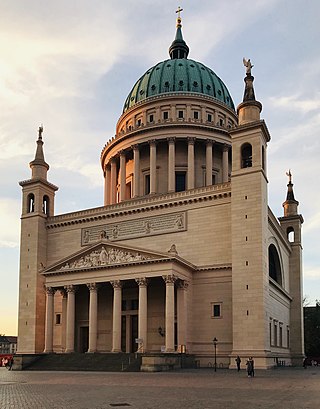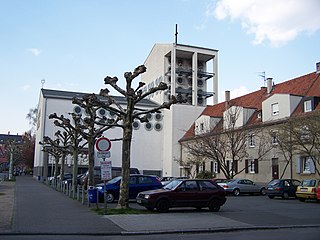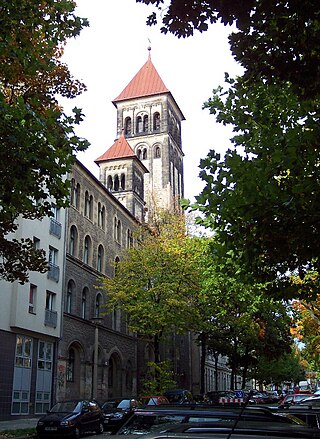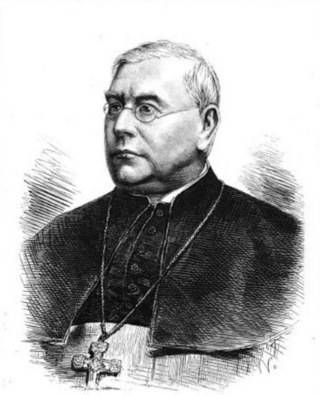
The Herz-Jesu-Kirche is the largest church in Graz, Austria. It was designed down to the last detail by architect Georg Hauberrisser and constructed from 1881 to 1887.

Johann Sebastian Bach composed the church cantata Herz und Mund und Tat und Leben, BWV 147 in 1723 during his first year as Thomaskantor, the director of church music in Leipzig. His cantata is part of his first cantata cycle there and was written for the Marian feast of the Visitation on 2 July, which commemorates Mary's visit to Elizabeth as narrated in the Gospel of Luke in the prescribed reading for the feast day. Bach based the music on his earlier cantata BWV 147a, written originally in Weimar in 1716 for Advent. He expanded the Advent cantata in six movements to ten movements in two parts in the new work. While the text of the Advent cantata was written by the Weimar court poet Salomo Franck, the librettist of the adapted version who added several recitatives is anonymous.

Alois Johannes Plum is an artist working in Mainz, Germany, who has acquired a national reputation for his stained glass, his paintings, and his plastic art. Plum has been active since the 1950s and his work decorates hundreds of churches and public buildings in Germany. He has created many characteristic stained glass windows in churches renovated or rebuilt after the destruction of World War II, and is especially noted for his reinterpretation of historic sacred space and his integration of glass and architecture with careful attention to the liturgical function of his art.

Trinity Church (Dreifaltigkeitskirche) was a Baroque Protestant church in Berlin, eastern Germany, dedicated to the Holy Trinity. It was opened in August 1739 and destroyed in November 1943, with its rubble removed in 1947.

The Lübeck Martyrs were three Roman Catholic priests – Johannes Prassek, Eduard Müller and Hermann Lange – and the Evangelical-Lutheran pastor Karl Friedrich Stellbrink. All four were executed by beheading on 10 November 1943 less than 3 minutes apart from each other at Hamburg's Holstenglacis Prison. Eyewitnesses reported that the blood of the four clergymen literally ran together on the guillotine and on the floor. This impressed contemporaries as a symbol of the ecumenical character of the men's work and witness. That interpretation is supported by their last letters from prison, and statements they themselves made during their time of suffering, torture and imprisonment. "We are like brothers," Hermann Lange said.

Neuhausen and Nymphenburg were boroughs of Munich, the capital of the German state of Bavaria. They were merged into the borough 09 - Neuhausen-Nymphenburg in 1992. For further information on the Munich boroughs, see: Boroughs of Munich.

St. Nicholas Church in Potsdam is a Lutheran church under the Evangelical Church in Berlin, Brandenburg and Silesian Upper Lusatia of the Evangelical Church in Germany on the Old Market Square in Potsdam. The central plan building in the Classicist style and dedicated to Saint Nicholas was built to plans by Karl Friedrich Schinkel in the years 1830 to 1837. The tambour of the 77-metre-high church that towers above the roofs of the city was built later, from 1843 to 1850. Its construction was taken over by Ludwig Persius and, from 1845, Friedrich August Stüler.

Herz und Mund und Tat und Leben, BWV 147.1, BWV 147a, is a cantata by Johann Sebastian Bach. He composed it in Weimar in 1716 for the fourth Sunday in Advent, 20 December. It is uncertain if the work was performed then. He later expanded the work in 1723 as Herz und Mund und Tat und Leben, BWV 147.

The Catholic Herz-Jesu-Kirche is a Neo-Gothic hall church located in the borough Mombach of the German city of Mainz. It is dedicated to the Sacred Heart. The church calendar of 1911 says: The name "Sacred Heart Church" originated from the idea to honour the memory of the great social bishop von Ketteler, who throughout his life was a pious and zealous admirer of the Sacred Heart, in his hundredth year of birth.

Praxis pietatis melica is a Protestant hymnal first published in the 17th century by Johann Crüger. The hymnal, which appeared under this title from 1647 to 1737 in 45 editions, has been described as "the most successful and widely-known Lutheran hymnal of the 17th century". Crüger composed melodies to texts that were published in the hymnal and are still sung today, including "Jesu, meine Freude", "Herzliebster Jesu", and "Nun danket alle Gott". Between 1647 and 1661, Crüger first printed 90 songs by his friend Paul Gerhardt, including "O Haupt voll Blut und Wunden".

Theodor Baierl was a German painter and fresco artist.

Herz Jesu-Lied, WAB 144, is the second of two motets of Anton Bruckner's St. Florian period, which is of uncertain authorship. If Bruckner was the composer, it was composed presumably in 1845-1846.

Herz Jesu Fechenheim is a Catholic church in the suburb Fechenheim of Frankfurt am Main, Hesse, Germany. The parish church of the Fechenheim congregation is part of the Roman Catholic Diocese of Limburg. On 1 January 2015 the parish became a Kirchort, part of the parish St. Josef Frankfurt am Main.

Herz Jesu Oberrad is a Catholic church in the suburb Oberrad of Frankfurt am Main, Hesse, Germany. The parish church of the Oberrad congregation is part of the Diocese of Limburg. It is a Kirchort, part of the parish St. Bonifatius Frankfurt.

Heilig Geist is the name of a Catholic church in the suburb Riederwald of Frankfurt am Main, Hesse, Germany. The parish church of the Riederwald congregation is part of the Roman Catholic Diocese of Limburg. On 1 January 2015 the parish became a Kirchort, part of the parish St. Josef, Frankfurt.

The Sacred Heart Church is a Catholic church located in Berlin-Prenzlauer Berg, externally built in Neo-Romanesque style. Designed by Christoph Hehl, professor of medieval architecture, the building was completed after 16 months of constructions in 1898. The Neo-Byzantine-style murals inside the church were done by Friedrich Stummel.
Friedrich Dörr was a German Catholic priest and professor of theology, who is known as a hymnwriter. He shaped the first common German Catholic hymnal, Gotteslob, published in 1975.

Georg von Hauberrisser was a German-Austrian architect.
Herz-Jesu-Kirche is a church in Graz, Austria.

Karl Klein was the Catholic Bishop of Limburg from 1886 to 1898. He restored the church after the Kulturkampf and won orders to found or reestablish monasteries in the diocese.




















